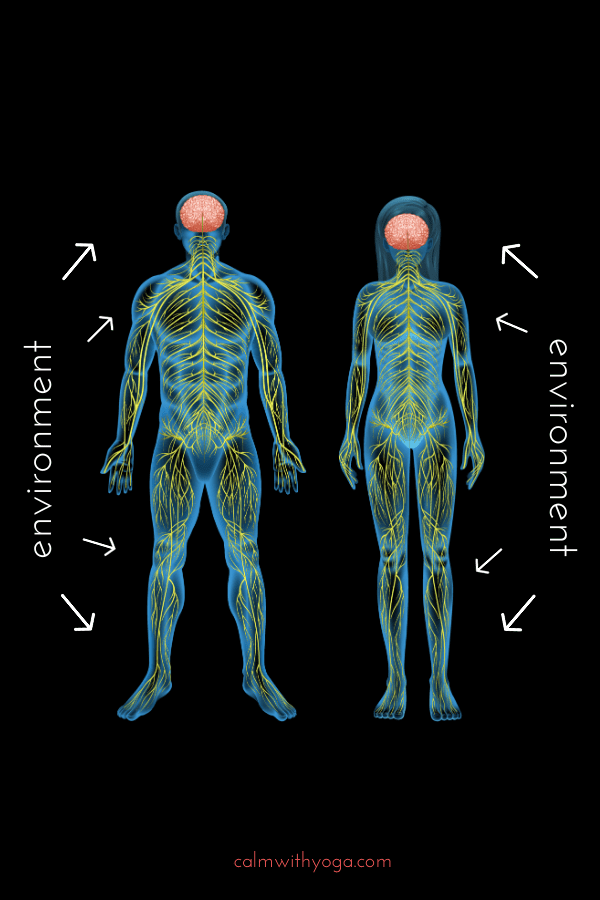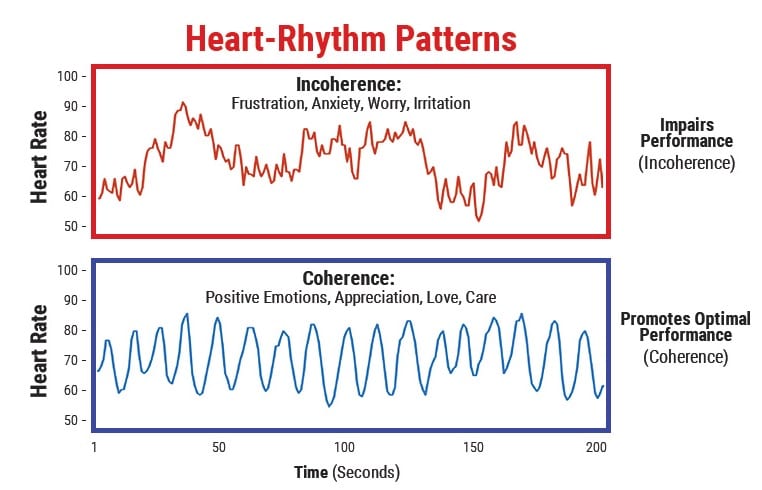Your brain guides the body by regulating the heart and other organs through the autonomic nervous system. – The Institute of Heartmath My anxiety got so bad it impacted my quality of life, well-being, and ultimately my mental and digestive health. The discomfort and suffering led me to the breaking point – and I knew I had to take matters into my own hands. If you’ve ever experienced a panic attack or anxiety you know that life (and your very body) often feel totally out of control. You feel helpless, scared, frustrated, and full-out dread most of the time. It’s a tough space to be in. In order to rise above it (haven’t experienced a panic attack in years), I’ve had to get to know my own nervous system and the role it plays in influencing the levels of anxiety I experience. Learning how to regain control over my own nervous system helped me not only damped the symptoms of anxiety and its effect, but it’s also helped me prevent future panic attacks too. I’m still working on it every day – and I suspect I will be for much of my life. I still deal with chronic muscle tension, occasional insomnia, and some lingering gut problems. But it has gotten much better. I’m slowly learning to approach stressful situations with more confidence and ease. I’m still conditioning myself to pause before I react and remember that not everything I perceive as a life-threatening is actually a threatening situation. This is where the nervous system comes in…
Your Nervous System Is Always Scanning Your Environment For You:
Our bodies are wise and intelligent. The crowning achievement of the intelligence of the human body is the nervous system. Everything you perceive through your senses – everything you can see, hear, taste, smell, intuit, and touch is processed through the nervous system. Like a good gatekeeper, it helps you maneuver through life by keeping track of every single little sensory detail of your experience so you don’t consciously have to. Your nervous system is constantly sifting through astounding amounts of data while it scans your environment and processes your surroundings. It matches incoming sensory information with previously recorded data in order to match relevant patterns:
When we experience chronic stress and overwhelm and we keep reacting in the same emotional way over and over, we condition our nervous system to (mis)read our environment based on past experiences, and the associations and perceptions we’ve formed around those experiences. Our nervous system then, being the intelligent processor and gatekeeper, diligently keeps seeking and running those old-patterned programs and subconscious emotional memories over and over recreating the same or similar experiences and reactions in an attempt to reconcile its pattern matching nature. Pair this with future anticipation and expectations based on past experiences, and it’s easy to see how we could be setting our own selves up for frustration. This creates a vicious cycle that leaves us feeling exhausted and drained. Most of this happens underneath our conscious and voluntary level of awareness…
Meet Your Autonomic Nervous System – the Silent Eavesdropper
Your Autonomic Nervous System (ANS) is the branch of your nervous system that: 1 – Regulates your internal bodily processes and major organs in order to ensure that health and well-being occur. 2- It is closely interconnected with your mental and emotional states because any emotion you experience is reflected in ANS function. (This means that your emotional states impact your body as a whole system.) 3- Operates and processes information below the level of your conscious awareness and voluntary control, hence why it’s known as the “automatic” nervous system. 4- Controls your inner world (internal functions) in relation and in response to what’s going on in your outer world. 5- Immediately responds to the stressors it detects in the environment. 6- Is comprised of two branches – the sympathetic nervous system (SNS) and the parasympathetic system (PSNS) The ANS connects the central nervous system (your brain and spinal cord) to the:
Heart Lungs Stomach Intestines Bladder Sex organs
The ANS is known as the “automatic” system because it’s primarily involved in regulating basic visceral processes and organ function in order to maintain homeostasis (balance and harmony in the body). The ANS operates beneath our conscious levels of awareness and independently of voluntary control. Anxiety, stressful emotions, fear, sexual arousal, and changes in sleep cycles do affect ANS activity. (1) You can deliberately influence ANS activity by training/programming yourself to help maintain a balance of the 2 ANS branches:
- The Sympathetic Nervous System (SNS):
“Fight/ flight/ freeze” response Energy mobilizing Acts like a gas pedal Associated with stress hormones It inhibits the digestive process by shutting down the stomach and intestinal activity. Increases the speed of heart beats and lowers heart rate variability (a marker of emotional resilience and physical health) Increases blood pressure Constricts blood vessels Stimulates adrenal glands Activates pupil dilation
- The Parasympathetic Nervous System (PSNS):
“Rest and digest” response Energy conserving Acts like a brake pedal Associated with regenerative hormones Activates the digestive process by stimulating the stomach and intestines. Decreases the speed of heart rate and increases heart rate variability (a marker of emotional resilience and physical health) Lowers blood pressure Improves digestion
Anxiety Can Create ANS Imbalance
These two subsystems function in an inverse, complementary opposite way, again, similar to the Yin-yang dynamic in Chinese Philosophy. – Dr. John Demartini, Researcher, Author, & Educator If there’s more of one, there’s less of the other. When we’re anxious, especially chronically so, our SNS is turned ON for way too long. It becomes overactive and that means that our PNS is underactive. The ANS is about balance (Remember it regulates bodily homeostasis/balance!) So having your SNS turned on for too long or too much is not good news. We anxious ones must keep in mind that for us, it’s about calming the SNS and activating the PNS. We’ve got to remember that a balanced ANS helps us deal with change and fear.
How To Override Your Stress Response By Learning To Activate The Relaxation Response Daily:
Since one of the major keys of calming anxiety is to teach the body and mind to relax here are 4 proven ways to take advantage of your own built-in chillaxing system…
- Stimulate Your Vagus Nerve The vagus nerve is a major PSNS nerve that runs from the base of your head down your ear and throat and down to your abdominal and digestive organs. The Vagus forms part of the involuntary/ autonomic nervous system and commands unconscious body functions, like regulating heart rate and controlling the digestive process. Benefits of an Activated (Stimulated) Vagus:
It plays an anti-inflammatory role in the body. People with chronic anxiety and depression have higher levels of inflammation in the gut and other parts of the body as well as increased risk of leaky gut, which we’ve seen is linked with chronic inflammation (2) Promotes neurogenesis (neuron regeneration and growth). One study found that “increasing adult neurogenesis is sufficient to reduce anxiety and depression-related behaviors.” Antidepressants increase neurogenesis, however, neurogenesis via chronic vagal nerve stimulation was found to be “much faster than that induced by antidepressant drugs.” (3) (4) It greatly increases BDNF levels in the brain. BDNF (brain-derived neurotrophic factor) is a brain chemical thought to play a role in the regulation of the stress response and mood disorders. People with anxiety and depression are found to have lower levels of BDNF, especially in the hippocampus. The great news is that the same study that linked chronic vagal nerve stimulation to neurogenesis also found that consistently stimulating the vagus also “did induce a robust increase in the expression of BDNF in the hippocampus.” (4)
Deep, long, continuous belly breaths stimulate the Vagus, and therefore activate the PNS’s Relaxation Response… 2) Breathe With Your Belly Initiating the Relaxation Response via belly breathing helps train the body to respond more calmly to stress. As Dr. Esther Sternberg, a stress and healing researcher at the Nat’l Institute of Mental Health, explains, the stress response (SNS) is the gas pedal, and the Vagus nerve is the brake: “The relaxation response is controlled by another set of nerves — the main nerve being the Vagus nerve. Think of a car throttling down the highway at 120 miles an hour. That’s the stress response, and the Vagus nerve is the brake. When you are stressed, you have your foot on the gas, pedal to the floor. When you take slow, deep breaths, that is what is engaging the brake.” (1) Research shows that just a few minutes of intention, slow, deep belly breaths can induce relaxation and inner calm. 3) Take up chanting Believe it or not, chanting and humming are a proven way to stimulate your vagus nerve and increase vagal tone. According to Dr. Stephen Porges and his Polyvagal Theory, the vibrations from the vocalizations of chanting out loud or humming actually “wake up” your vagus nerve so it comes online. 4) Take up a daily gratitude practice It turns out that a regular gratitude practice is powerful medicine and can even help to re-wire an anxious brain for the better. Maybe that’s why the yogic practice of contentment (Santosha) is one of the key practices on the true yogic path. The Institute of Heartmath has spent the last 20-something years researching how certain emotional states impact not only HRV but your overall heart intelligence and well-being. According to their research positive emotions and positive feelings such as gratitude, appreciation, contentment, and inspiration activate the PSNS by increasing heart-rate variability. By the same token, negative emotions create a state of incoherence and lower HRV. Heartmath measured HRV while experiencing different emotional states and found that: “Distinct heart rhythm patterns characterize different emotional states… Sustained emotions such as appreciation, care, compassion, and love generate a smooth, sine-wave-like pattern in the heart’s rhythms. This reflects increased order in higher-level control systems in the brain, increased synchronization between the two branches of the ANS, and a general shift in autonomic balance towards an increased parasympathetic activity.” (1) The graphs below are illustrations of HMI HRV readings. The top red is during a moment of frustration. Notice the erratic, jagged pattern. The bottom blue was recorded during a moment of appreciation. Notice the more harmonious, sine-wave like pattern. REFERENCES : (1) Institute of Heartmath, Building Personal Resilience Guide, 2014 (2) https://www.ncbi.nlm.nih.gov/pmc/articles/PMC1430829/ (3) https://www.ncbi.nlm.nih.gov/pmc/articles/PMC2879889/ (4) https://www.ncbi.nlm.nih.gov/pubmed/25833129




